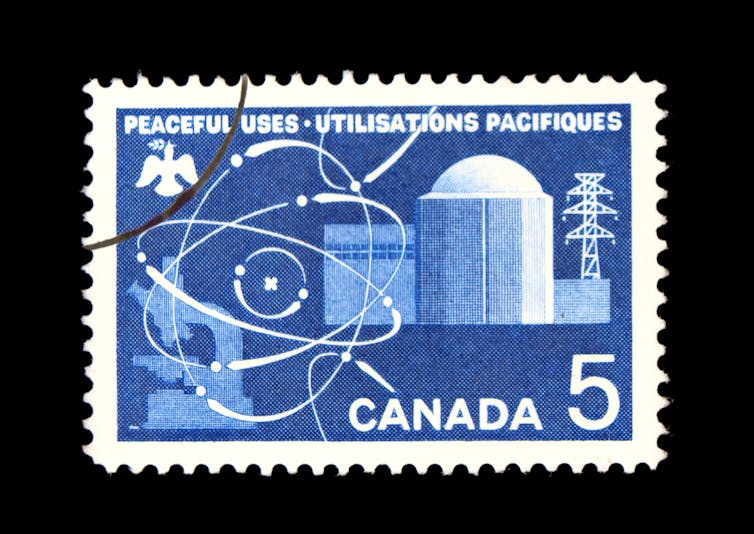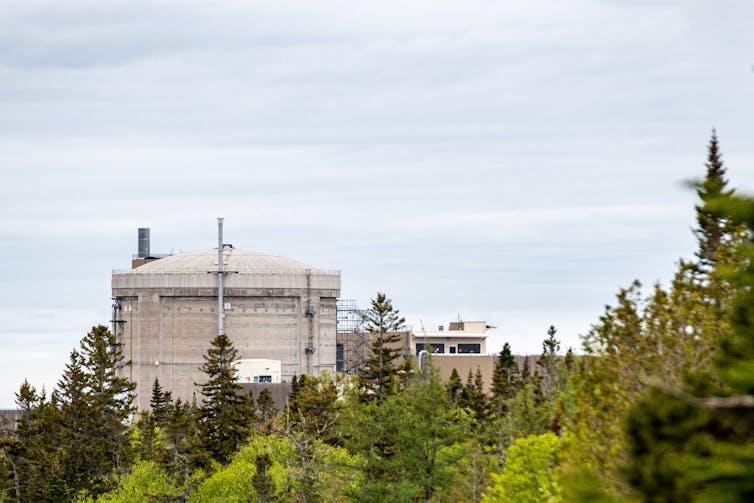Nuclear power: Why molten salt reactors are problematic and Canada investing in them is a waste

A Canadian stamp from 1980 representing the peaceful applications of nuclear energy. (Shutterstock)
September 14, 2021
One of the beneficiaries of the run-up to a potential federal election has been the nuclear energy industry, specifically companies that are touting new nuclear reactor designs called small modular reactors. The largest two financial handouts have been to two companies, both developing a specific class of these reactors, called molten salt reactors (MSRs).
First, in October 2020, Canada’s minister of innovation, science and industry announced a $20-million grant to Ontario-based Terrestrial Energy and its integral molten salt reactor (IMSR) design. In March 2021, New Brunswick-based Moltex received $50.5 million from the Strategic Innovation Fund and Atlantic Canada Opportunities Agency.
As a physicist who has analyzed different nuclear reactor designs, including small modular reactors, I believe that molten salt reactors are unlikely to be successfully deployed anytime soon. MSRs face difficult technical problems, and cannot be counted on to produce electricity consistently.
How they work
Molten salt reactors use melted chemicals like lithium fluoride or magnesium chloride to remove the heat produced within the reactor. In many MSRs, the fuel is also dissolved in a molten salt.
These designs are very different from traditional reactor designs — currently, the Canada Deuterium Uranium (CANDU) design dominates Canada’s nuclear energy landscape. CANDU uses heavy water (water with deuterium, the heavier isotope of hydrogen) to transport heat, slow down or “moderate” neutrons produced during fission, and natural uranium fabricated into solid pellets as fuel. Slower neutrons are more effective in triggering fission reactions as compared to highly energetic, or fast, neutrons.
Terrestrial’s IMSR is fuelled by uranium which contains higher concentrations of uranium-235, a lighter isotope as compared to uranium found in nature (natural uranium), which is used in CANDU reactors. The enriched uranium is dissolved in a fluoride salt in the IMSR. The IMSR also uses graphite, instead of heavy water used in CANDU reactors, to moderate neutrons.
Moltex’s Stable Salt Reactor (SSR), on the other hand, uses a mixture of uranium and plutonium and other elements, dissolved in a chloride salt and placed inside a solid assembly, as fuel. It does not use any material to slow down neutrons.
Because of the different kinds of fuel used, these MSR designs need special facilities — not present in Canada currently — to fabricate their fuel. The enriched uranium for the IMSR must be produced using centrifuges, while the Moltex design proposes to use a special chemical process called pyroprocessing to produce the plutonium required to fuel it. Pyroprocessing is extremely costly and unreliable.
Both processes are intimately linked to the potential to make fissile materials used in nuclear weapons. Earlier this year, nine non-proliferation experts from the United States wrote to Prime Minister Justin Trudeau expressing serious concerns “about the technology Moltex proposes to use.”
One of the beneficiaries of the run-up to a potential federal election has been the nuclear energy industry, specifically companies that are touting new nuclear reactor designs called small modular reactors. The largest two financial handouts have been to two companies, both developing a specific class of these reactors, called molten salt reactors (MSRs).
First, in October 2020, Canada’s minister of innovation, science and industry announced a $20-million grant to Ontario-based Terrestrial Energy and its integral molten salt reactor (IMSR) design. In March 2021, New Brunswick-based Moltex received $50.5 million from the Strategic Innovation Fund and Atlantic Canada Opportunities Agency.
As a physicist who has analyzed different nuclear reactor designs, including small modular reactors, I believe that molten salt reactors are unlikely to be successfully deployed anytime soon. MSRs face difficult technical problems, and cannot be counted on to produce electricity consistently.
How they work
Molten salt reactors use melted chemicals like lithium fluoride or magnesium chloride to remove the heat produced within the reactor. In many MSRs, the fuel is also dissolved in a molten salt.
These designs are very different from traditional reactor designs — currently, the Canada Deuterium Uranium (CANDU) design dominates Canada’s nuclear energy landscape. CANDU uses heavy water (water with deuterium, the heavier isotope of hydrogen) to transport heat, slow down or “moderate” neutrons produced during fission, and natural uranium fabricated into solid pellets as fuel. Slower neutrons are more effective in triggering fission reactions as compared to highly energetic, or fast, neutrons.
Terrestrial’s IMSR is fuelled by uranium which contains higher concentrations of uranium-235, a lighter isotope as compared to uranium found in nature (natural uranium), which is used in CANDU reactors. The enriched uranium is dissolved in a fluoride salt in the IMSR. The IMSR also uses graphite, instead of heavy water used in CANDU reactors, to moderate neutrons.
Moltex’s Stable Salt Reactor (SSR), on the other hand, uses a mixture of uranium and plutonium and other elements, dissolved in a chloride salt and placed inside a solid assembly, as fuel. It does not use any material to slow down neutrons.
Because of the different kinds of fuel used, these MSR designs need special facilities — not present in Canada currently — to fabricate their fuel. The enriched uranium for the IMSR must be produced using centrifuges, while the Moltex design proposes to use a special chemical process called pyroprocessing to produce the plutonium required to fuel it. Pyroprocessing is extremely costly and unreliable.
Both processes are intimately linked to the potential to make fissile materials used in nuclear weapons. Earlier this year, nine non-proliferation experts from the United States wrote to Prime Minister Justin Trudeau expressing serious concerns “about the technology Moltex proposes to use.”
Difficult questions
Experience with MSRs has not been very encouraging either. All current designs draw upon the only two MSRs ever built: the 1954 Aircraft Reactor Experiment that ran for just 100 hours and the Molten Salt Reactor Experiment that operated intermittently from 1965 to 1969. Over those four years, the latter reactor’s operations were interrupted 225 times; of these, only 58 were planned. The remaining were due to various unanticipated technical problems. In other words, the reactor had to be shut down at least once every four out of five weeks — that is not what one would expect of a reliable power plant.
Even the U.S. Atomic Energy Commission that had funded the U.S. MSR program for nearly two decades raised difficult questions about the technology in a devastating 1972 report. Many of the problems identified continue to be technical challenges confronting MSR designs.
Another basic problem with MSRs is that the materials used to manufacture the various reactor components will be exposed to hot salts that are chemically corrosive, while being bombarded by radioactive particles. So far, there is no material that can perform satisfactorily in such an environment. A 2018 review from the Idaho National Laboratory could only recommended that “a systematic development program be initiated” to develop new alloys that might work better. There is, of course, no guarantee that the program will be successful.
These problems and others have been identified by various research laboratories, ranging from France’s Institut de radioprotection et de sûreté nucléaire (IRSN) to the Nuclear Innovation and Research Office in the United Kingdom. Their conclusion: molten salt reactors are still far from proven.
As the IRSN put it in 2015: “numerous technological challenges remain to be overcome before the construction of an MSR can be considered,” going as far as saying that it does not envision construction of such reactors “during the first half of this century.”

The Point Lepreau nuclear generating station in New Brunswick, where Moltex proposes to build a molten salt reactor. (Shutterstock)
Problematic solutions
Should an MSR be built, it will also saddle society with the challenge of dealing with the radioactive waste it will produce. This is especially difficult for MSRs because the waste is in chemical forms that are “not known to occur in nature” and it is unclear “which, if any, disposal environment could accommodate this high-level waste.” The Union of Concerned Scientists has also detailed the safety and security risks associated with MSR designs.
The Liberal government’s argument for investing in molten salt reactors is that nuclear power is necessary to mitigate climate change. There are good reasons to doubt this claim. But even if one were to ignore those reasons, the problems with MSRs laid out here show that they cannot be deployed for decades.
The climate crisis is far more urgent. Investing in technologies that are proven to be problematic is no way to deal with this emergency.
Experience with MSRs has not been very encouraging either. All current designs draw upon the only two MSRs ever built: the 1954 Aircraft Reactor Experiment that ran for just 100 hours and the Molten Salt Reactor Experiment that operated intermittently from 1965 to 1969. Over those four years, the latter reactor’s operations were interrupted 225 times; of these, only 58 were planned. The remaining were due to various unanticipated technical problems. In other words, the reactor had to be shut down at least once every four out of five weeks — that is not what one would expect of a reliable power plant.
Even the U.S. Atomic Energy Commission that had funded the U.S. MSR program for nearly two decades raised difficult questions about the technology in a devastating 1972 report. Many of the problems identified continue to be technical challenges confronting MSR designs.
Another basic problem with MSRs is that the materials used to manufacture the various reactor components will be exposed to hot salts that are chemically corrosive, while being bombarded by radioactive particles. So far, there is no material that can perform satisfactorily in such an environment. A 2018 review from the Idaho National Laboratory could only recommended that “a systematic development program be initiated” to develop new alloys that might work better. There is, of course, no guarantee that the program will be successful.
These problems and others have been identified by various research laboratories, ranging from France’s Institut de radioprotection et de sûreté nucléaire (IRSN) to the Nuclear Innovation and Research Office in the United Kingdom. Their conclusion: molten salt reactors are still far from proven.
As the IRSN put it in 2015: “numerous technological challenges remain to be overcome before the construction of an MSR can be considered,” going as far as saying that it does not envision construction of such reactors “during the first half of this century.”

The Point Lepreau nuclear generating station in New Brunswick, where Moltex proposes to build a molten salt reactor. (Shutterstock)
Problematic solutions
Should an MSR be built, it will also saddle society with the challenge of dealing with the radioactive waste it will produce. This is especially difficult for MSRs because the waste is in chemical forms that are “not known to occur in nature” and it is unclear “which, if any, disposal environment could accommodate this high-level waste.” The Union of Concerned Scientists has also detailed the safety and security risks associated with MSR designs.
The Liberal government’s argument for investing in molten salt reactors is that nuclear power is necessary to mitigate climate change. There are good reasons to doubt this claim. But even if one were to ignore those reasons, the problems with MSRs laid out here show that they cannot be deployed for decades.
The climate crisis is far more urgent. Investing in technologies that are proven to be problematic is no way to deal with this emergency.
MV Ramana
Simons Chair in Disarmament, Global and Human Security at the Liu Institute for Global Issues, University of British Columbia
Disclosure statement
MV Ramana receives funding from the Social Sciences and Humanities Research Council.
Partners

Simons Chair in Disarmament, Global and Human Security at the Liu Institute for Global Issues, University of British Columbia
Disclosure statement
MV Ramana receives funding from the Social Sciences and Humanities Research Council.
Partners

No comments:
Post a Comment